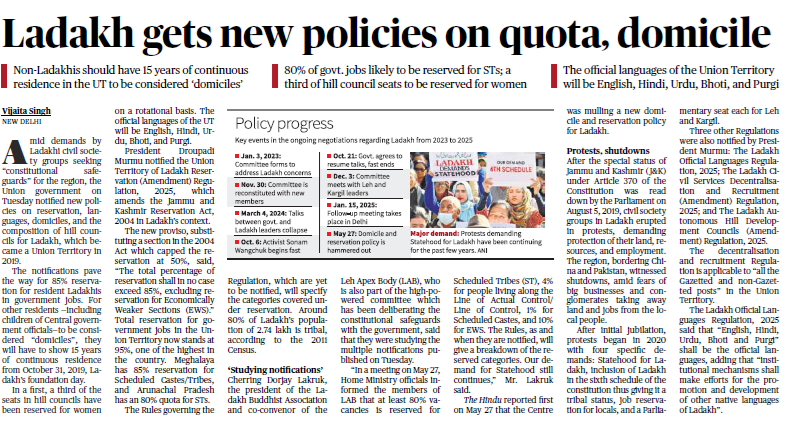

SOURCE: Indian express- Economy
MAIN ARTICLE:(summary)
Union Finance Minister Nirmala Sitharaman warned that narcotics smuggling is now one of the biggest threats to India, especially targeting schools and colleges. She emphasized the need for greater coordination among revenue and enforcement agencies to counter this threat.
Why in News:
Union Finance Minister Nirmala Sitharaman raised serious concerns over the rising threat of narcotics smuggling, stating that schools and colleges are increasingly being targeted by drug peddlers.
Major Threat:
Narcotics smuggling identified as one of the biggest internal threats to India.
Target Groups:
Schools and colleges are increasingly being targeted by drug peddlers.
Technology Use:
Revenue Intelligence officers urged to: Use tech tools to tackle threats from the dark web. Monitor cross-border e-commerce for illicit drug trade.
Enforcement Strategy:
Enforcement must be rooted in both data and dharma (ethical values). Greater emphasis on coordinated actions among multiple agencies. Not just focus on big masterminds; smaller operatives must also be apprehended.
Challenges:
Smugglers using digital platforms, anonymous networks, and encrypted channels. Need for information-sharing and real-time action.
Prelims Facts:
DRI (Directorate of Revenue Intelligence) is India’s apex anti-smuggling agency. “No good if you catch the small fish only” – FM’s quote on enforcement depth.

Source: Indian Express – Economy
Key Points:
India and EU are likely to finalize a full FTA, instead of an interim deal. Discussions include both trade and geopolitical issues. Objective:
To create a comprehensive and dynamic trade framework. Significance:
Strengthens India–EU relations. Boosts trade, investment, and cooperation in tech, data, and climate. Promotes India’s role in multilateral economic diplomacy.

Source: The Indian Express Category:Environment & Ecology | Biodiversity
Topic: Tiger-Human Conflict Rises Due to Shrinking Prey Base
Why in News?
A national-level report (2022 Tiger Census) by Wildlife Institute of India and National Tiger Conservation Authority (NTCA) flagged increased tiger-human conflict in Jharkhand, Chhattisgarh, and Odisha due to shrinking prey base.
THEME :
India has 3,600+ wild tigers, ~70% of the global population. Despite tiger population growth, wild ungulate prey (chital, sambar, wild pig, gaur) is declining in central Indian forests
Result: Tigers move towards human settlements and hunt domestic animals, increasing conflict risk. Prey base stable in: Madhya Pradesh, Maharashtra, and Western Ghats.
Prey depletion severe in: Jharkhand, Odisha, Chhattisgarh.
Report Basis: Data from 2022 Tiger Census Methods included: Field surveys Camera trap images Forest cover and prey analysis
Major Reserves at Risk: Palamau Tiger Reserve (Jharkhand) Sunabeda Wildlife Sanctuary (Odisha) Guru Ghasidas National Park (Chhattisgarh)
Recommendations: Habitat restoration Rebuilding prey base Reduce dependence on tourism-centric reserves Encourage inter-state coordination and targeted conservation
Prelims Facts: NTCA is a statutory body under the Wildlife (Protection) Act, 1972 WII (Wildlife Institute of India) is under the Ministry of Environment, Forest and Climate Change (MoEFCC)

Source: Indian express- science & tech
Location: San Francisco
Speaker: Sridhar Ramaswamy (CEO, Snowflake)
Theme: Transition of Artificial Intelligence (AI) from experimentation to real-world application.
- Emphasis on making complex AI technologies simple and accessible.
- AI being used in enterprise production environments, beyond research and labs.

SOURCE: THE HINDU NEWSPEPAR– Governance
In response to longstanding demands from Ladakhi civil society groups for constitutional safeguards and regional empowerment, the Union Government of India has introduced significant policy changes for the Union Territory (UT) of Ladakh. These measures aim to protect the economic rights, cultural identity, and governance structures of Ladakhi residents.
Key Policy Changes:
- 85% Job Reservation for Locals:
The government has amended the Jammu and Kashmir Reservation Act, 2004, to provide 85% reservation in government jobs for local residents of Ladakh. This includes:- 80% for Scheduled Tribes (STs),
- 4% for residents near the Line of Actual Control (LAC),
- 1% for Scheduled Castes (SCs), and
- 10% for Economically Weaker Sections (EWS).
This brings the total reservation to 95%, one of the highest in the country.
- Domicile Criteria:
To be considered a domicile of Ladakh, individuals must demonstrate 15 years of continuous residence from October 31, 2019, the day Ladakh was designated a Union Territory. This applies to all residents, including children of central government officials. - Hill Council Representation:
One-third of the seats in the Ladakh Autonomous Hill Development Councils (LAHDC) will be reserved for women on a rotational basis, promoting gender equality in local governance. - Official Languages:
The official languages of Ladakh will now include English, Hindi, Urdu, Bhoti, and Purgi. The regulation also encourages the promotion and development of other native languages of Ladakh. - Decentralization and Recruitment:
The Ladakh Civil Services Decentralisation and Recruitment (Amendment) Regulation, 2025, applies to all gazetted and non-gazetted posts in the UT, aiming to decentralize recruitment processes and enhance local employment opportunities.
Ongoing Demands:
Despite these advancements, civil society groups like the Leh Apex Body (LAB) continue to advocate for:
- Statehood for Ladakh,
- Inclusion in the Sixth Schedule of the Constitution,
- Establishment of a separate Ladakh Public Service Commission, and
- Increased representation in national governance.
These policy changes mark a significant step towards addressing the aspirations of Ladakhi residents, though ongoing dialogue and implementation will be crucial in meeting their full demands.

Source: THE HINDU
Researchers from the Vellore Institute of Technology (VIT), Tamil Nadu, have identified antibiotic-producing bacteria in the Rajgir hot spring lake, Nalanda district, Bihar. This discovery, published in the Indian Journal of Microbiology, underscores the untapped potential of India’s hot springs as reservoirs of novel antimicrobial agents.
- Thermophilic Bacteria in Extreme Environments:
- The Rajgir hot spring lake maintains water temperatures up to 45°C, with surrounding soil temperatures ranging between 43–45°C.
- Such extreme conditions are inhospitable to most organisms but are ideal for thermophilic bacteria, which thrive in high-temperature environments.
- Prevalence of Actinobacteria:
- Actinobacteria comprised 40–43% of the microbial diversity in the lake.
- This group includes genera known for producing potent antibiotics, such as Streptomyces and Micromonospora.
- Antimicrobial Activity Against Pathogens:
- Seven strains of Actinobacteria demonstrated significant antimicrobial activity against several human pathogens, including Escherichia coli, Salmonella typhimurium, Klebsiella pneumoniae, Pseudomonas aeruginosa, and Staphylococcus aureus.
- Isolation of Bioactive Compounds:
- From the Actinomycetales bacterium spp., researchers isolated diethyl phthalate, which exhibited inhibitory effects against Listeria monocytogenes, a bacterium responsible for listeriosis.
- This compound could potentially be developed into a therapeutic agent for treating listeriosis.
Significance:
- Antimicrobial Resistance Mitigation: The rise of antimicrobial resistance poses a global health threat. Discovering new antibiotic sources is crucial to combat resistant strains.
- Pharmaceutical Potential: The identified strains and compounds offer promising leads for developing new antibiotics and other therapeutic agents.
- Industrial Applications: Beyond medicine, thermophilic bacteria have applications in biotechnology, including enzyme production and waste treatment.

SOURCE: The hindu
In 2025, India overtook Japan to become the world’s 4th largest economy by nominal GDP, reaching $4.34 trillion. This economic leap is the result of a decade-long strategy emphasizing reforms, resilience, and self-reliance.
- India’s Economic Ranking
- India’s nominal GDP (2025): $4.34 trillion
- Japan’s GDP (2025): $4.31 trillion
- Growth since 2015: Doubled from $2.1 trillion (↑ 105%)
- Projected to become 3rd largest economy by 2027 (surpassing Germany) (Source: IMF)
- Major Growth Drivers
- Infrastructure Development:
- Projects like National Infrastructure Pipeline, PM Gati Shakti, and Atmanirbhar Bharat attracted investments across sectors.
- Geopolitical Advantage:
- India has become a preferred alternative for global supply chains due to political stability and a skilled workforce.
- Energy Sector Transformation
- Clean Energy:
- Record addition of 30 GW of renewable energy in FY 2024-25.
- Coal’s share in electricity dropped from 60% to <50%.
- Biofuels & Green Hydrogen:
- Ethanol blending in petrol: from 1.5% (2013) to 19.7% (2025)
- Savings: ₹1.26 lakh crore in forex + income for farmers/distillers.
- National Green Hydrogen Mission: Target of 5 million tonnes by 2030.
- Gas Infrastructure:
- Natural gas pipelines expanded from 25,000 km (2024) to a target of 33,000 km by 2030.
- Policy Reforms in Energy Sector
- Exploration & Production (E&P):
- Open Acreage Licensing Policy (OALP) simplified oil/gas block access.
- ‘No-Go’ areas reduced by 99%.
- Incentives:
- Shared infrastructure for E&P players, and premium gas pricing for new wells.
- Technology Initiatives:
- Mission Anveshan, National Seismic Programme, and gravity mapping improved exploration in frontier basins (e.g., Andamans, Mahanadi).
Significance
|
|
|---|---|
|
|
|
|
|
|
- India’s rise to the 4th largest economy reflects sound policy-making, strategic investments, and energy sector reforms. It showcases India’s resilience and globel leadership potential in the coming decade.

SOURCE: The hindu
- The Russia-Ukraine conflict has escalated in June 2025 with intensified military actions and diplomatic talks.
- Operation Spider’s Web (June 1, 2025): Ukraine conducted a large-scale covert drone attack on Russian airbases (Olenya, Dyagilevo, Ivanovo, Belaya, Ukrainka), damaging/destroying over 40 aircraft, including strategic bombers.
- Kerch Bridge Attack (June 3, 2025): Ukraine claimed an underwater explosive attack damaging this critical Russia-Crimea logistical link, disrupting Russian military supply routes.
- Russian Retaliation: Rocket strikes targeted civilian areas in Sumy, Ukraine, killing at least 4 civilians and injuring 25, shortly after failed peace talks.
- Diplomatic Talks (June 2, 2025): Russia, Ukraine, and US delegations met in Istanbul, agreed on a prisoner exchange (175 personnel each), and scheduled further talks in June.
- International Relations Insight: Shows complexity of multilateral negotiations and importance of third-party mediation.
- Security Studies Insight: Highlights evolving warfare with drones and cyber tactics.
- Geopolitical Insight: Emphasizes strategic significance of infrastructure control in conflict dynamics.
The conflict reveals the close link between military conflict and diplomacy. Continued diplomatic engagement is vital, and global responses will shape the crisis’s future trajectory.
